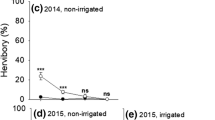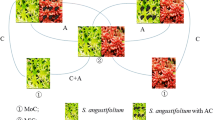Abstract
Kyllinga nervosa (Steud.) and Sporobolus kentrophyllus (K. Schum.) are co-dominant plants of the Serengeti short-grass plains, Tanzania. The plains are characterized by seasonal and sporadic rainfall and currently support in excess of 1.5 million migratory ungulates. The interactive effect of simulated bovine urine and water availability were tested on the competitive interactions of these species in the laboratory.
Sporobolus kentrophyllus was a superior competitor to K. nervosa over the tested treatment levels with respect to growth and reproductive effort. Sporobolus kentrophyllus exhibited rapid growth in response to urine addition, leading to a significant species × urine interaction while reduced growth by K. nervosa in response to low water availability explained the significant species × water interaction and is likely explained by K. nervosa's shallow root system. Kyllinga nervosa, however, appears to be more tolerant of low nitrogen conditions based on its similar growth with and without the urine treatment. The effect of intraspecific competition on total biomass was similar for S. kentrophyllus and K. nervosa. Competition resulted in increased size differences (asymmetry) for K. nervosa and for the interspecific competition treatments compared to the size differences observed for plants grown individually (in absence of competition).
Total reproductive biomass was reduced most by competition with S. kentrophyllus, irrespective of target species. The water treatment did not influence reproduction while the urine treatment significantly increased reproductive biomass and interacted with target species, competitor species, and yielded a three-way urine × target × competitor species interaction.
Results suggest that codominance of these two species in the Serengeti is regulated by water availability, nitrogen input from grazers, and local neighbor identity.
Similar content being viewed by others
References
Banyikwa, F. F. 1988. The growth response of two East African perennial grasses to defoliation, nitrogen fertilizer and competition. Oikos 51, 25–30.
Berendse, F. 1983. Interspecific competition and niche differentiation between Plantago lanceolata and Anthoxanthum odoratum in a natural hayfield. Journal of Ecology 71, 379–390.
Campbell, B. D. and Grime, J. P. 1992. An experimental test of plant strategy theory. Ecology 73, 15–29.
Coughenour, M. B., McNaughton, S. J. and Wallace, L. L. 1985a. Responses of an African graminoid (Themeda triandra Forsk.) to frequent defoliation, nitrogen, and water: a limit of adaptation to herbivory. Oecologia 68, 105–110.
Coughenour, M. B., McNaughton, S. J. and Wallace, L. L. 1985b. Responses of an African tall-grass (Hyparrhenia filipendula stapf.) to defoliation and limitations of water and nitrogen. Oecologia68, 80–86.
Dawson, T. E. 1993. Hydraulic lift and water use by plants: implications for water balance, performance and plant-plant interactions. Oecologia95, 565–574.
Day, T. A. and Detling, J. K. 1990. Grassland patch dynamics and herbivore grazing preference following urine deposition. Ecology 71, 180–188.
DeWit, H. A. 1978. Soils and grassland types of the Serengeti Plains (Tanzania). PhD thesis, University of Wageningen.
Gedroc, J. J., McConnaughay, K. D. M. and Coleman, J. S. 1996. Plasticity in root/shoot partitioning: optimal, ontogenetic, or both? Functional Ecology 10, 44–50.
Goldberg, D. E. and Barton, A.M. 1992. Patterns and consequences of interspecific competition in natural communities: a review of field experiments with plants. American Naturalist 139, 771–801.
Grace, J. B. 1995. On the measurement of plant competition intensity. Ecology 76, 305–308.
Grime, J. P. 1977. Evidence for the existence of three primary strategies in plants and its relevance to ecological and evolutionary theory. American Naturalist 111, 1169-1194.
Harper, J. L. 1977. Population Biology of Plants. Academic Press, London.
Hartvigsen, G. 1995. Competitive interactions within and between two Serengeti grassland plants. PhD thesis, Syracuse University.
Hartvigsen, G. and McNaughton, S. J. 1995. Tradeoff between height and relative growth rate in a dominant grass from the Serengeti ecosystem. Oecologia 102, 273–76.
Hutchinson, G. E. 1959. Homage to Santa Rosalia, or why are there so many kinds of animals? American Naturalist 93, 145–159.
Jobin, K. N. and Keough, R. G. 1979. The elemental composition of herbage at urine-patch sites in a ryegrass pasture. Journal of Agricultural Science 92, 571–574.
MacArthur, R. H. and Wilson, E. O. 1967. The Theory of Island Biogeography. Princeton University Press, Princeton.
Markham, J. H. and Chanway, C. P. 1996. Measuring plant neighbor effects. Functional Ecology 10, 548–549.
McNaughton, S. J. 1979. Grazing as an optimization process: grass-ungulate relationships in the Serengeti. American Naturalist 113, 691–703.
McNaughton, S. J. 1983. Serengeti grassland ecology: the role of composite environmental factors and contingency in community organization. Ecological Monographs 53, 291–320.
McNaughton, S. J. 1984. Grazing lawns: animals in herds, plant form, and coevolution. American Naturalist 124: 863–886.
McNaughton, S. J., Wallace, L. L. and Coughenour, M. B. 1983. Plant adaptation in an ecosystem context: effects of defoliation, nitrogen, and water on growth of an African C4 sedge. Ecology 64, 307–318.
McNaughton, S. J., F. F. Banyikwa, and M. M. McNaugton. 1997. Promotion of the cycling of diet-enhancing nutrients by African grazers. Science 278: 1798–1800.
Ruess, R. W. 1988. The interaction of defoliation and nutrient uptake in Sporobolus kentrophyllus, a short-grass species from the Serengeti. Oecologia 77, 550–556.
Ruess, R. W. and McNaughton, S. J. 1984. Urea as a promotive coupler of plant-herbivore interactions. Oecologia 63, 331–337.
Schulze, E.-D. and Hall., A. E. 1982. Stomatal responses, water loss and CO2 assimilation rates of plants in contrasting environments. In Encyclopedia of Plant Physiology, vol. 12B, pp. 181–230.
Sinclair, A. R. E. 1979. The Serengeti environment. In Serengeti: dynamics of an ecosystem (ed. A. R. E. Sinclair and M. Norton-Griffiths), pp. 31–45. University of Chicago Press, Chicago.
Stillwell, M. A. 1983. Effects of bovine urinary nitrogen on the nitrogen cycle of a shortgrass prairie. Dissertation. Colorado State University, Fort Collins, Colorado, USA.
Thomas, R. J., Logan, K. A. B., Ironside, A. D. and Milne, J. A. 1986. Fate of urine-N applied to an upland grass sward. Plant and Soil 91, 425–427.
Tilman, D. 1990. Constraints and tradeoffs: toward a predictive theory of competition and succession. Oikos 58, 3–15.
Tilman, D. and Wedin, D. 1991. Dynamics of nitrogen competition between successional grasses. Ecology 72, 1038–1049.
Vance, R. R. 1985. The stable coexistence of two competitors for one resource. American Naturalist 136, 72–86.
Volterra, V. 1926. Variations and fluctuations of the numbers of individuals in animal species living together. Reprinted 1931, in Animal Ecology (ed. R. N. Chapman). McGraw-Hill, New York.
Weiner, J. 1990. Asymmetric competition in plant populations. Trends in Ecology and Evolution5, 360–364.
Williams, K. J. 1992. The interactive effects of water stress and defoliation on the growth and physiology of an African graminoid (Themeda triandra). PhD thesis, Syracuse University.
Author information
Authors and Affiliations
Rights and permissions
About this article
Cite this article
Hartvigsen, G. Competition between co-dominant plants of the Serengeti plains depends on competitor identity, water, and urine. Plant Ecology 148, 31–41 (2000). https://doi.org/10.1023/A:1009835424490
Issue Date:
DOI: https://doi.org/10.1023/A:1009835424490




